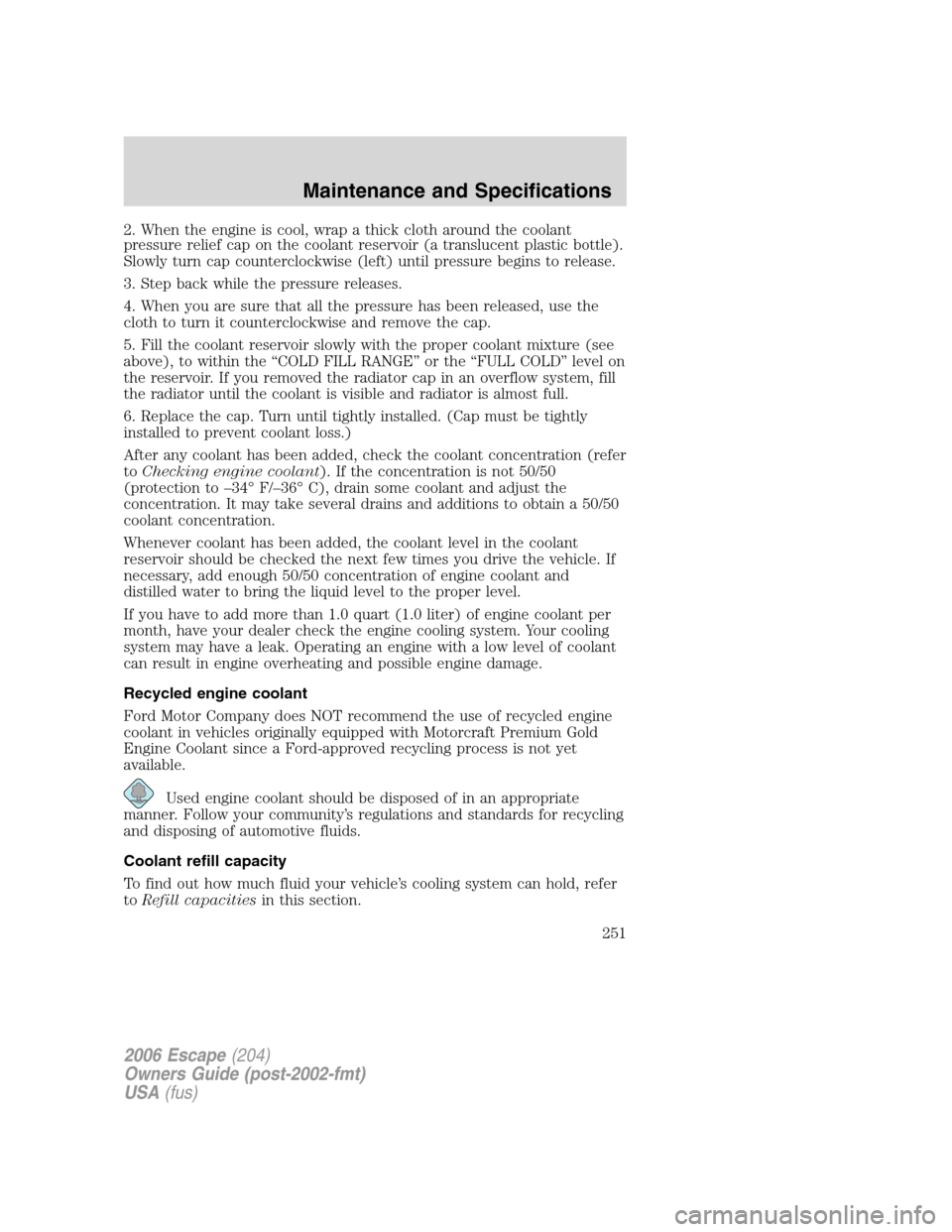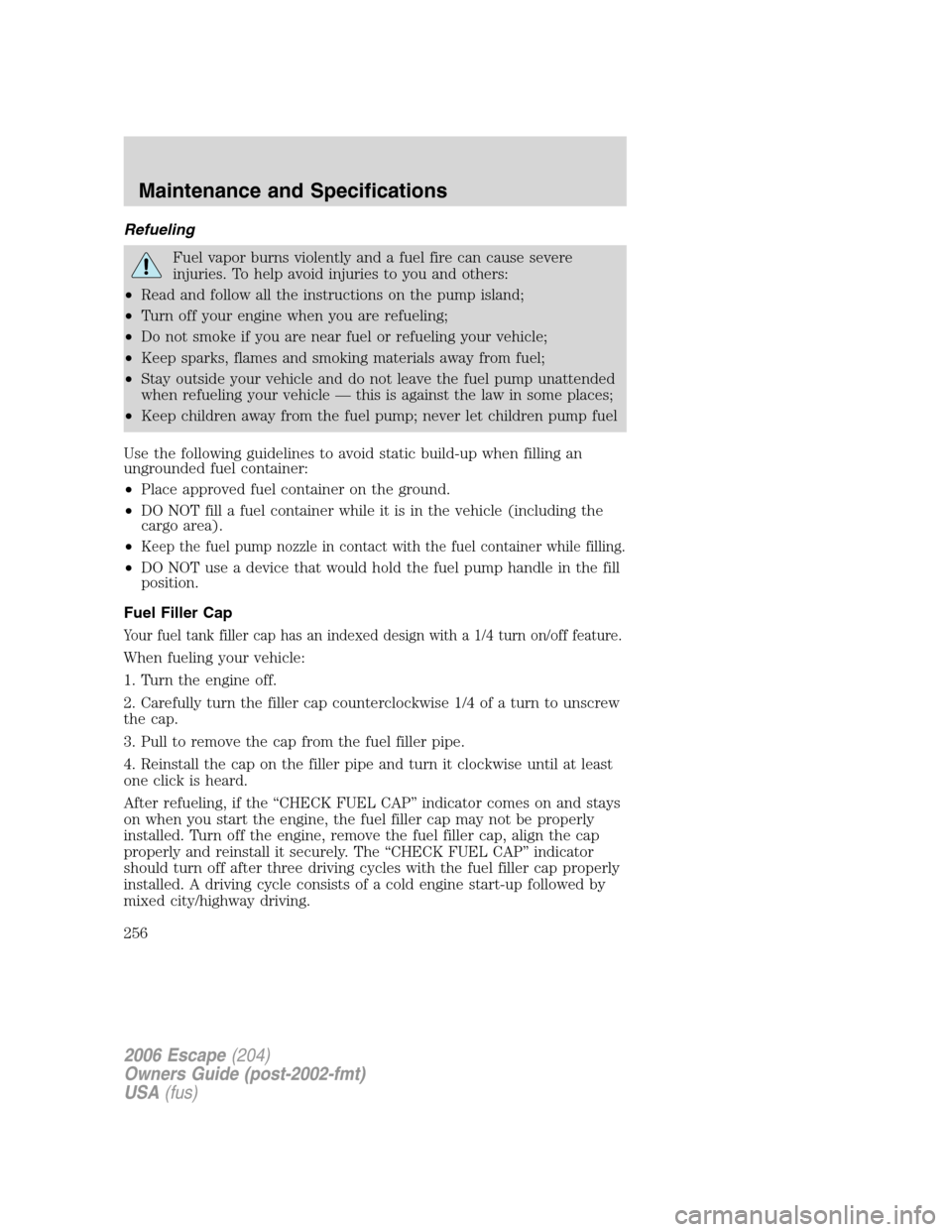2006 FORD ESCAPE clock
[x] Cancel search: clockPage 248 of 288

When the battery is disconnected or a new battery installed, the
transmission must relearn its adaptive strategy. As a result of this, the
transmission may shift firmly. This operation is considered normal and
will not affect function or durability of the transmission. Over time the
adaptive learning process will fully update transmission operation to its
optimum shift feel.
If the battery has been disconnected or a new battery has been installed,
the clock and the preset radio stations must be reset once the battery is
reconnected.
•Always dispose of automotive
batteries in a responsible manner.
Follow your local authorized
standards for disposal. Call your
local authorized recycling center
to find out more about recycling
automotive batteries.
ENGINE COOLANT
Checking engine coolant
The concentration and level of engine coolant should be checked at the
mileage intervals listed inscheduled maintenance information.The
coolant concentration should be maintained at 50/50 coolant and distilled
water, which equates to a freeze point of -34°F (-36°C). Coolant
concentration testing is possible with a hydrometer or antifreeze tester
(such as the Rotunda Battery and Antifreeze Tester, 014–R1060). The level
of coolant should be maintained at the “FULL COLD” level or within the
“COLD FILL RANGE” in the coolant reservoir. If the level falls below, add
coolant per the instructions in theAdding engine coolantsection.
Your vehicle was factory-filled with a 50/50 engine coolant and water
concentration. If the concentration of coolant falls below 40% or above
60%, the engine parts could become damaged or not work properly.A
50–50 mixture of coolant and water provides the following:
•Freeze protection down to -34°F (-36°C).
•Boiling protection up to 265°F (129°C).
•Protection against rust and other forms of corrosion.
•Enables calibrated gauges to work properly.
L
E
A
D
RETURN
RECYCLE
2006 Escape(204)
Owners Guide (post-2002-fmt)
USA(fus)
Maintenance and Specifications
248
Page 251 of 288

2. When the engine is cool, wrap a thick cloth around the coolant
pressure relief cap on the coolant reservoir (a translucent plastic bottle).
Slowly turn cap counterclockwise (left) until pressure begins to release.
3. Step back while the pressure releases.
4. When you are sure that all the pressure has been released, use the
cloth to turn it counterclockwise and remove the cap.
5. Fill the coolant reservoir slowly with the proper coolant mixture (see
above), to within the “COLD FILL RANGE” or the “FULL COLD” level on
the reservoir. If you removed the radiator cap in an overflow system, fill
the radiator until the coolant is visible and radiator is almost full.
6. Replace the cap. Turn until tightly installed. (Cap must be tightly
installed to prevent coolant loss.)
After any coolant has been added, check the coolant concentration (refer
toChecking engine coolant). If the concentration is not 50/50
(protection to –34° F/–36° C), drain some coolant and adjust the
concentration. It may take several drains and additions to obtain a 50/50
coolant concentration.
Whenever coolant has been added, the coolant level in the coolant
reservoir should be checked the next few times you drive the vehicle. If
necessary, add enough 50/50 concentration of engine coolant and
distilled water to bring the liquid level to the proper level.
If you have to add more than 1.0 quart (1.0 liter) of engine coolant per
month, have your dealer check the engine cooling system. Your cooling
system may have a leak. Operating an engine with a low level of coolant
can result in engine overheating and possible engine damage.
Recycled engine coolant
Ford Motor Company does NOT recommend the use of recycled engine
coolant in vehicles originally equipped with Motorcraft Premium Gold
Engine Coolant since a Ford-approved recycling process is not yet
available.
Used engine coolant should be disposed of in an appropriate
manner. Follow your community’s regulations and standards for recycling
and disposing of automotive fluids.
Coolant refill capacity
To find out how much fluid your vehicle’s cooling system can hold, refer
toRefill capacitiesin this section.
2006 Escape(204)
Owners Guide (post-2002-fmt)
USA(fus)
Maintenance and Specifications
251
Page 256 of 288

Refueling
Fuel vapor burns violently and a fuel fire can cause severe
injuries. To help avoid injuries to you and others:
•Read and follow all the instructions on the pump island;
•Turn off your engine when you are refueling;
•Do not smoke if you are near fuel or refueling your vehicle;
•Keep sparks, flames and smoking materials away from fuel;
•Stay outside your vehicle and do not leave the fuel pump unattended
when refueling your vehicle — this is against the law in some places;
•Keep children away from the fuel pump; never let children pump fuel
Use the following guidelines to avoid static build-up when filling an
ungrounded fuel container:
•Place approved fuel container on the ground.
•DO NOT fill a fuel container while it is in the vehicle (including the
cargo area).
•
Keep the fuel pump nozzle in contact with the fuel container while filling.
•DO NOT use a device that would hold the fuel pump handle in the fill
position.
Fuel Filler Cap
Your fuel tank filler cap has an indexed design with a 1/4 turn on/off feature.
When fueling your vehicle:
1. Turn the engine off.
2. Carefully turn the filler cap counterclockwise 1/4 of a turn to unscrew
the cap.
3. Pull to remove the cap from the fuel filler pipe.
4. Reinstall the cap on the filler pipe and turn it clockwise until at least
one click is heard.
After refueling, if the “CHECK FUEL CAP” indicator comes on and stays
on when you start the engine, the fuel filler cap may not be properly
installed. Turn off the engine, remove the fuel filler cap, align the cap
properly and reinstall it securely. The “CHECK FUEL CAP” indicator
should turn off after three driving cycles with the fuel filler cap properly
installed. A driving cycle consists of a cold engine start-up followed by
mixed city/highway driving.
2006 Escape(204)
Owners Guide (post-2002-fmt)
USA(fus)
Maintenance and Specifications
256
Page 283 of 288

interior .....................................235
interior trim ............................234
plastic parts ............................233
washing ....................................231
waxing .....................................231
wheels ......................................232
wiper blades ............................234
Climate control (see Air
conditioning or Heating) ......38–39
Clock ............................................32
Clock adjust
6-CD in dash .......................20, 25
AM/FM/CD .................................29
AM/FM/Tape/CD .......................32
Single CD ..................................29
Clutch
fluid ..........................................265
operation while driving ..........181
recommended shift speeds ....182
Console ........................................56
overhead ....................................54
Controls
power seat .................................94
Coolant
checking and adding ..............248
refill capacities ................251, 270
specifications ..................272, 274
Cruise control
(see Speed control) ....................59
Customer Assistance ................194
Ford Extended Service
Plan ..........................................228
Getting assistance outside
the U.S. and Canada ..............229
Getting roadside assistance ...194
Getting the service you
need .........................................222
Ordering additional owner’s
literature .................................230The Dispute Settlement
Board .......................................225
Utilizing the
Mediation/Arbitration
Program ...................................228
D
Daytime running lamps
(see Lamps) ................................43
Defrost
rear window ..............................40
Dipstick
automatic transmission
fluid ..........................................265
engine oil .................................242
Doors
lubricant specifications ..........272
Driving under special
conditions ..................180, 188, 191
sand .........................................189
snow and ice ...........................192
through water .................190, 193
E
Electronic message center .........62
Emergencies, roadside
jump-starting ..........................214
Emission control system ..........262
Engine ........................................274
cleaning ...................................232
coolant .....................................248
fail-safe cooling .......................252
idle speed control ...................246
lubrication specifications ......272,
274
refill capacities ........................270
service points ..................239–240
starting after a collision .........196
2006 Escape(204)
Owners Guide (post-2002-fmt)
USA(fus)
Index
283
Page 286 of 288

Power distribution box
(see Fuses) ...............................201
Power mirrors .............................58
Power point .................................55
Power steering ..........................174
fluid, checking and adding ....264
fluid, refill capacity ................270
fluid, specifications .........272, 274
Power Windows ...........................57
Preparing to drive your
vehicle ........................................175
R
Radio ................................19, 27, 31
Rear window defroster ...............40
Relays ........................................196
Remote entry system
illuminated entry ..........47, 87–88
Reverse sensing system ...........184
Roadside assistance ..................194
Roof rack .....................................71
S
Safety Belt Maintenance ..........108
Safety belts (see Safety
restraints) ..................100, 104–107
Safety Canopy ...................122, 124
Safety defects, reporting ..........230
Safety restraints ........100, 104–108
belt minder .............................109
extension assembly ................108
for adults .........................105–107
for children .....................127–128
Occupant Classification
Sensor ......................................101safety belt maintenance .........108
warning light and chime ........109
Safety seats for children ..........130
Safety Compliance
Certification Label ....................276
Seat belts
(see Safety restraints) .............100
Seats ............................................93
child safety seats ....................130
heated ........................................95
Servicing your vehicle ..............237
Setting the clock
AM/FM/In-dash 6 CD ..........20, 25
AM/FM/Tape/CD .......................32
Snowplowing .................................8
Spark plugs, specifications ......269,
274
Special notice
ambulance conversions ..............8
utility-type vehicles ....................8
Specification chart,
lubricants ...........................272, 274
Speed control ..............................59
Starting your vehicle ........169–171
jump starting ..........................214
Steering wheel
tilting .........................................53
T
Temperature control
(see Climate control) .................38
Tilt steering wheel ......................53
Tires ...................................141–143
alignment ................................153
care ..........................................152
changing ..................................205
2006 Escape(204)
Owners Guide (post-2002-fmt)
USA(fus)
Index
286